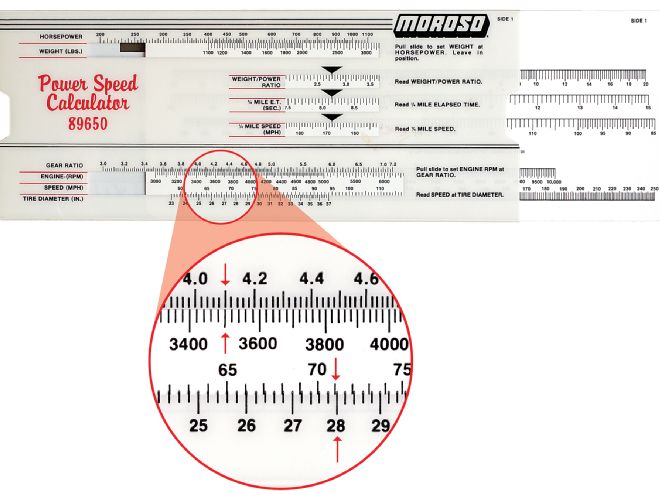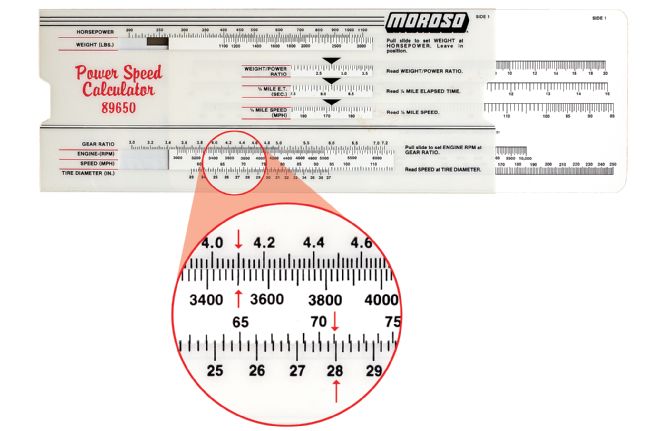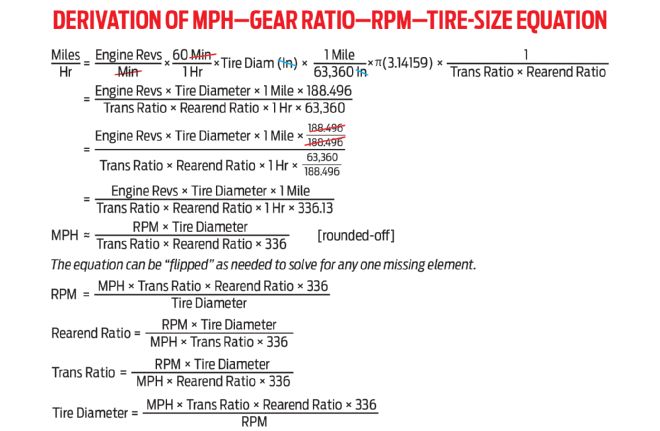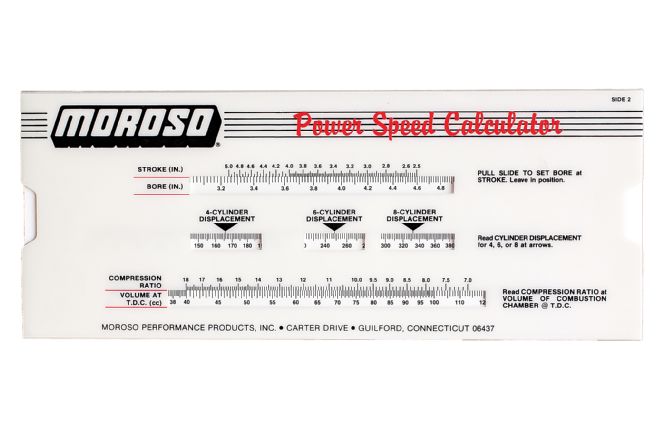
In the Oct. 2014 Pit Stop, you explained why horsepower and torque always cross at 5,252 rpm. And in the past you’ve published formulas for the relationship between miles per hour (mph), axle ratio, engine revolutions per minute (rpm), and tire size. But where does the “336” constant in that equation come from?
Bill Spizzirri
Schaumburg, Illinois
Vehicle speed (mph), engine speed (rpm), tire diameter (inches), trans gear ratio, and rear axle gear ratio are all interrelated. If you know four out of five of these values, you can determine what the unknown value is (or what it needs to be to achieve your desired goals). But to do that you have to convert different units of measurement to a common value: revolutions per minute to revolutions per hour, and inches to miles. There is also the conversion from rotary motion (cranks, gears, and axle shafts) to forward motion at the tire/ground contact patch, which is why you need to factor in tire diameter and circumference.
 Moroso’s analog slide rule-style performance calculator (PN 89650) is still available today. The double-sided calculator let gearheads calculate with reasonable accuracy a wide range of performance factors. At the top on the front side is a scale for calculating weight/power ratio as well as quarter-mile e.t.’s and mph based on vehicle horsepower and weight. The bottom half is for figuring out the vehicle speed—engine rpm—gear ratio—tire size equation (assumes 1:1 trans high-gear). In this example, the calculator determined 4.10:1 rear gears, a 3,500-rpm engine speed, and 28-inch-od tires equate to 71 mph.
Moroso’s analog slide rule-style performance calculator (PN 89650) is still available today. The double-sided calculator let gearheads calculate with reasonable accuracy a wide range of performance factors. At the top on the front side is a scale for calculating weight/power ratio as well as quarter-mile e.t.’s and mph based on vehicle horsepower and weight. The bottom half is for figuring out the vehicle speed—engine rpm—gear ratio—tire size equation (assumes 1:1 trans high-gear). In this example, the calculator determined 4.10:1 rear gears, a 3,500-rpm engine speed, and 28-inch-od tires equate to 71 mph.
The unreduced formula for finding vehicle mph involves multiplying engine rpm by the number of minutes in an hour (60) and multiplying the tire diameter by pi (π) to find the circumference of the tire in inches. Then multiply both of these individual products together, and divide by the overall gear ratio times the number of inches in a mile (63,360). “336” is simply the reduced, rounded-off whole-number value of these various constant values. See the accompanying box for the unreduced equation and how it’s “reduced” to the form we use every day with its “336” constant.

Unlike other versions of this formula you may have seen, I now include trans gear ratio as a factor. Back in the day, most transmissions were 1:1 in high gear, but today’s transmissions have overdrive high gears, so you need to factor that in as well. This also lets you solve for any trans gear, not just the top gear—which is helpful for determining optimal gear-ratio spreads.
If you need to run multiple scenarios to hone in on a combo that meets your performance goals, I’d recommend putting the formulas into a spreadsheet or a programmable calculator. There’s also another option that dates back to the “BC” (Before Computer/Before Calculator) days: old-school analog (aka “hand-operated”) rectangular, slide rule-like, power/speed calculators. Moroso still offers one of the most comprehensive ones, as shown in the photos below. There are also round variations that we used to call “dream wheels.” That style is still available from Iskenderian (PN RATIOCOMP). In a more modern vein, Summit Racing has an online gear-ratio calculator .
 The flip side of Moroso’s calculator will give you engine displacement (based on bore, stroke, and number of cylinders) and compression ratio (based on chamber/cylinder TDC volume).
The flip side of Moroso’s calculator will give you engine displacement (based on bore, stroke, and number of cylinders) and compression ratio (based on chamber/cylinder TDC volume).